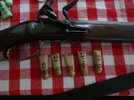Well, 1.5 is turning out to be my Jeager's favorite, and it has a relatively short barrel. (30-32" I forget) (Colerain) But it is of large caliber. I've been shooting 1fg in my Bess for years now, (swiss) with no substantial increase in fouling, compared to Swiss 2fg which is what I used in it the first year or so I had it. My main attraction to 1.5 and 1fg in the Bess and the Jeager is that it packs up against the touchhole nice and tight. I can just look and see the main charge. Don't have to pick at nothing. I think, believe, and just my opinion is that gives the fastest ignition time, although the Jeager is so fast it's hard to perceive, most of the time, that there is any lag at all. I mean, I touch the set-trigger and it goes off, just like a .30-06. I shot the Jeager a bit yesterday, and I was just slightly aware of the cock striking the frizzen once or twice, (or more correctly "hammer") but that is unusual. Normally, touch the trigger and there is an instant (seemingly) bang.
Bessie is "pretty fast", but I can feel or am aware of the frizzen flying forward before the bang. But again, she seems to fire fastest with 1fg packed up tight against the touch hole. And of course, being individuals, Bess likes a generous helping of prime, the Jeager just a small amount.


